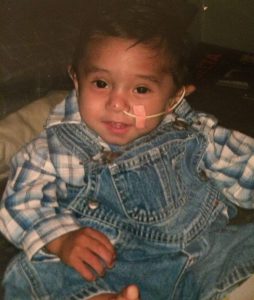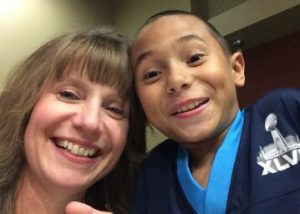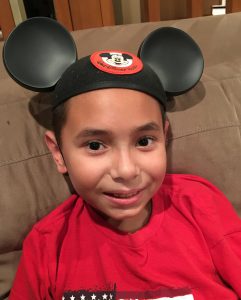
In honor of Donate Life Month, On the Pulse shares an inspiring story of a mother and her son that symbolizes the true act of ‘paying it forward’. Kaden Hollis was only 1 years old when he underwent a lifesaving liver transplant. Throughout Kaden’s journey, his mother Cindie knew that although the gift of life her son received could never be paid back, it could be paid forward — which is what she did when a friend was in desperate need.
Kaden Hollis was just 3 months old when his mother, Cindie Hollis, began noticing signs that indicated her baby was not well.
The whites of his eyes were turning yellow, which quickly spread throughout his entire body. He had a constant itch that resulted in awful cuts all over his delicate skin from the scratching. It was evident that Kaden had a severe case of jaundice. After numerous doctor visits and careful monitoring of his condition over the next several months, Kaden’s health was not improving. To find the answer to what was causing her son’s worrisome condition Hollis went to Seattle Children’s Hospital when he was 13 months old.
It was then that Hollis received the difficult news that her son had progressive familial intrahepatic cholestasis, or PFIC, a disorder that causes progressive liver disease, which typically leads to liver failure.
“PFIC causes an ineffective circulation of bile in your body,” said Dr. Patrick Healey, pediatric transplant surgeon at Seattle Children’s Hospital and the doctor who later performed Kaden’s lifesaving transplant surgery. “Kaden clearly suffered from the symptoms that were typical to a child with PFIC — jaundice, pruritus and growth failure.”
 Dr. Simon Horslen, medical director of liver and intestinal transplant at Seattle Children’s who has treated Kaden since his early visits to the hospital, said that patients with this condition experience an extreme level of discomfort that can take a tremendous toll on a child’s ability to sleep, eat and develop.
Dr. Simon Horslen, medical director of liver and intestinal transplant at Seattle Children’s who has treated Kaden since his early visits to the hospital, said that patients with this condition experience an extreme level of discomfort that can take a tremendous toll on a child’s ability to sleep, eat and develop.
“We have seen a number of patients like Kaden and this condition can lead to an intolerable quality of life,” said Horslen. “Witnessing the level of itchiness Kaden was experiencing is the kind that makes everyone else in the room also itch and feel the same terrible degree of discomfort.”
When Kaden was nearly 2 years old, his illness reached its peak.
“His body was so small and fragile that he didn’t have the ability to walk or even crawl like a normal toddler could,” Hollis said.
After several more tests, it was determined that Kaden’s liver was failing and he was in need of a liver transplant.
Seattle Children’s has the only pediatric liver transplant program in the Pacific Northwest. The hospital’s transplant doctors are among the most experienced pediatric liver transplant teams in the country with patient outcomes that are among the best in the nation. For this reason, Hollis felt confident in the care Kaden would be receiving for his transplant surgery.
In September 2006, Kaden was put on the donor list.
“It was a long and nerve-racking wait. You’re constantly anticipating that ‘one call’ and it feels like forever,” said Hollis.
That call finally came three months later.
“It was the morning after Kaden went to a holiday get-together with us. Although he was sick, I remember his smiles lit up the room that night, which gave me a sense of hope after watching him struggle for so long,” Hollis recalls. “The next day, when I received the call that Kaden would finally receive his transplant, I froze out of disbelief. As I was crying tears of joy, I immediately called my husband to share the amazing news.”
A brand new outlook

After hours of anxiously waiting for Kaden to emerge from the operating room, Hollis found herself looking at her son, seeing him in a way she had never seen him before.
“For the first time, he finally looked at peace,” she said.
Kaden recovered quickly from his surgery. Just a day after waking up, he was ready to enjoy the things he never had the chance to enjoy when he was sick — things like chocolate pudding and a slice of cheese pizza.
“I have a vivid picture in my head of Kaden dancing on his hospital bed with a stethoscope draped around his neck and a diaper on his head,” Hollis said as she laughed. “Seeing Kaden’s courage and unwavering joy throughout his illness changed my entire outlook on life.”
Paying it forward
Driven by a desire to give back, Hollis’ life shifted gears once Kaden’s health improved and he was out of the hospital. Throughout the course of Kaden’s treatment, she was heavily involved in various support groups at the hospital, consoling and offering advice to other parents who faced similar obstacles with their children. Since leaving the hospital, Hollis wanted to find ways to further her mission of giving back.
After seeing Kaden blossom into a happy and healthy boy thanks to the lifesaving gift he received as a baby, Hollis made it a point to pay it forward in the best way she possibly could — by donating one of her kidneys to a co-worker’s wife.
Hollis had known her co-worker for several years, and was well aware that his wife had suffered from complications with diabetes.
“I knew that his wife was sick, but when complications caused her kidneys to start failing and her husband was unfortunately not a match to be a potential donor, I knew I needed to do something,” Hollis said.
Hollis was immediately evaluated to see if she was a match — and low and behold, she was.
The months leading up to the surgery required Hollis to undergo numerous tests and adhere to dietary restrictions. When the surgery day arrived, Hollis was ready to give the gift of life to the one person she knew that needed it the most. The nine-hour surgery was a success, not only for Hollis, but for her co-worker’s wife as well.
“Although making the decision to donate was difficult, I’ve never regretted it for a second,” she said. “Our lives were changed due to the generosity of a donor who never even met us, and I knew it was my wish to pass that incredible gift on. I’ve never felt more fulfilled.”
For Hollis and others who decide to become a living donor, the impact is profound. According to the United Network for Organ Sharing (UNOS), more than 120,000 people in the U.S. are on the waiting list for a lifesaving organ, and sadly, more than 22 people die each day waiting for a transplant.
“The altruistic acts of people like Cindie really impresses me,” said Horslen. “The need for organ donors is great and her decision to step forward as a way to say thank you is admirable. It wasn’t just a noble gesture; she provided a gift that gave someone a second chance at life.”
Looking Ahead
 Kaden, now 11, is thriving and reaching all of his milestones.
Kaden, now 11, is thriving and reaching all of his milestones.
“Kaden is a really smart, charming young man who is growing normally and doing very well,” said Horslen. “It’s extremely gratifying as a doctor to see patients, like Kaden, return to their normal life, perform well in school and be able to do all the things kids ought to be doing. That’s why we do what we do.”
In reflecting on how far she and Kaden have come, Hollis said they now have a new lease on life.
“Our experience has given our life new meaning and made us extremely grateful for where we are today,” she said.
If you’re interested in giving the gift of life and becoming an organ donor, please register your wish in the Donate Life Today registry.
Resources
- The Gift of Life: What to Know About Organ Donation and Transplant
- Brother Donates Kidney to Sister, “I Always Knew I Would Be the One”
- Seattle Children’s Transplant Center
- Donate Life America
- United Network for Organ Sharing

